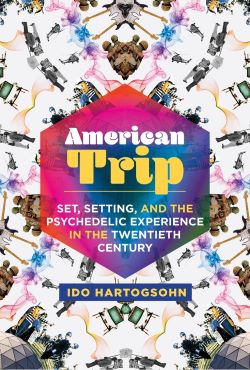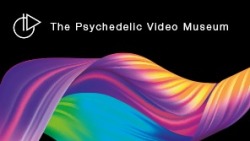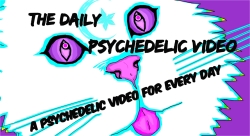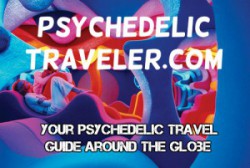Rapé, sananga, kambo, psychedelics: Why spiritual seekers seek pain
Recent encounters with a number of shamanic medicines whose most immediate effect is pain and physical discomfort led me to consider the role of pain in the psychedelic healing process.
A shamanic ceremony in which I recently participated included 4 types of medicines: ayahuasca, tobacco, rapé and sananga. While the first two are probably known to most readers (though some might be unfamiliar with consecrated use of tobacco), rapé and sananga seem to necessitate an introduction. Rapé, the better known of the two, is a shamanic snuff medicine. It is blown into the nostril by a practitioner who uses a pipe, causing a sudden burning sensation in the nose and the sinuses, as well as a running nose. Such uncomfortable sensations are followed by a number of supposed benefits. On the most immediate level, the use of the substance is followed by a feeling of clarity in the head and the nasal cavities. Other alleged benefits ascribed to rapé are significantly more dramatic. According to the site “Shamanic Snuff”, for example, rapé use “helps to re-align and open all your chakras, improves your grounding, releases any sickness on physical, emotional, mental and spiritual levels.”
I had known rapé before. The sananga, on the other hand, was entirely new to me. These “sacred” eye drops (colirio) are instilled in the eye by a practitioner, and are said to cause intense burning sensation, an experience which persists for a number of minutes, during which the patient is directed to breathe deeply and into the pain. Sananga is reported to sharpen visual perception and even allow users to experience a sort of infra-red night vision. Again, on the less immediate level there is talk of far more dramatic benefits. Sananga is said to solve a host of eye disease and also burn the inner anger residing in the individual, leading to an intense state of relaxation following the period of pain. The shaman who introduced sananga to me explained that the pain caused by sananga causes the release of endorphins, produced by the body to ease the pain. These endorphins stay in the body after the sananga is gone, leading to a feeling of utmost relaxation.
Personally, I have a strong aversion to sudden intense pain, plus I have ultra-sensitive eyes, so I gave up on sananga without a second though. However, I did have rapé blown into my nose, and I could see some of the appeal of the experience.
Having witnessed these two pain related experiences which are sought after by modern day spiritual seekers from within the ayahuasca subculture made me reconsider a third experience which is popular in this subculture and which involves intense pain. Some of the readers might have heard of the kambo frog extract, a medicine based on the venom extracted from the body of the giant tree frog or giant monkey frog and which is inserted into the body of the person being treated, causing extreme bodily discomfort which includes nausea, feebleness, and a dramatic swelling around the head which causes the person to temporarily resemble a frog. In the days following the experience, people report feeling greatly cleansed and invigorated, with some reporting dramatic reduction in the need for sleep and food. And again there is a host of alleged benefits from this profoundly discomforting process, including a reinvigoration of the immune system, detoxification of the liver and the entire digestive system, as well as the curing of a many of diseases from Parkinson to depression.
The protestant work ethic and the psychedelic work ethic
Considering these three phenomena of the rapé, the sananga and the kambo, all of which can be encountered mostly in relation to the milieu of ayahuasca communities, it seems as if a pattern is emerging: a growing popularity of substances which are used to induce pain or physical discomfort of sorts. This phenomena might not be all that new. As often noted by McKenna, alternative techniques for the achievement of altered, visionary states of consciousness traditionally included various types of pain and discomfort such as self-flagellation, self-mutilation, sleep deprivation, and prolonged fasting. Yet the question remains, why? Why do spiritual seekers seem so keen on experiences involving intense pain or discomfort?
Before we try and answer this question, it should be noted that the experience of pain and discomfort can be seen as an inherent part of the psychedelic experience in general , and not just in rapé, sananga and kambo. Some kind and degree of discomfort is invariably related to most types of purging psychedelic experiences. The degree to which the ingestion a plant hallucinogen is followed by the feeling of purging is generally dependent upon the degree of discomfort that is involved in its use. Ayahuasca, Peyote and even magic mushrooms, are notoriously known for their foul taste, and for the intense bodily (and mental) discomfort they cause, which commonly includes nausea, vomiting and diarrhea, among other phenomena. Yet these plant psychedelics leave their users feeling purged and cleansed. Even synthetic psychedelics such as LSD often include a degree of bodily discomfort, and can feel purging to some degree. MDMA, on the other hand, is all joy and love with very little pain or discomfort, which is perhaps the reason why it has no purging effect. In fact, an intense MDMA experience is all too often accompanied by a devastating bummer or down.
Experiencing difficulty and illness to their fullness is an essential element of the psychedelic voyage. Such difficulty and illness can take both bodily as well as mental form, and its expression reaches its peak in death/rebirth experiences, in which the individual must die in order to be reborn again. Death as the ultimate form of illness leading to rebirth as the ultimate form of cleanse.
It almost seems as if the psychedelic experience and perhaps the visionary experience in general have some kind of protestant ethic which is supported by the body and the nervous system. Drugs which only make you feel good, but don’t challenge you, like cocaine, heroin and speed, also precipitate a down which occurs once the drug is out of the nervous system, and are also the ones that make you addicted. By contrast, drugs whose use involves a great degree of physical discomfort, such as the natural psychedelics, are non-toxic, non-addictive and leave you feeling purged. No pain, no gain. It’s also almost as if psychedelic use supports a kind of spiritual protestant work ethic in which one has to suffer in order to rise and soar.
This is particularly ironic and interesting since the protestant work ethic was one of the major reasons why people in the west came to distrust psychedelics in the first place. During the 1960s psychedelic controversy, psychedelics were often portrayed as “cheap thrills”, thrills that get their users to a state of “instant nirvana” too easily, without having earned it honestly. Participators in the psychedelic debate such as Timothy Leary and Sidney Cohen used to argue about whether relishing the view from the top of the mountain is the same whether you got there using a ski-lift or after a long a and arduous hike; The top of the mountain being, of course, the mystical experience, arrived at through sustained spiritual work, or through the use of drugs. Cohen maintained that “the mountain climber has sweated and striven against the dangers. His view must be different from the ski lift rider’s because it incorporates the struggle and the triumph.”[1] “The shortcut may get you to the same summit. The view may be the same, but what a difference between the one who sweated and struggled to get there, and the one who rode to the top on the back of a chemical carrier.”[2] Timothy Leary, on his end, insisted that “It’s not a case of either/or, it’s both/and. If you want, you can sweat and suffer hiking today, and you can choose to zoom up tomorrow using technology … all the secrets of life are shortcuts. I think people deserve every revelation they can get.”[3] Does a chemically triggered spiritual experience have the same value as one arrived us through hard, laborious work, and is it even legitimate? Such questions were high on everybody’s mind in the 1960s moral discussion about psychedelics.[4]
The protestant work ethic also played a central part in the social discussion about psychedelics users. Hippies were accused of being lazy, unproductive, and disruptive of the work ethic. The hippie ethic which replaced work with play was a main object of criticism in papers written by psychiatrists who were concerned that psychedelic use could lead to a “generation of psychedelic dropouts”[5], and worried that psychedelic users would “never be able to gain the lost ground” leading “less productive … lives.”[6]
In my PhD research The Psycho-Social Construction of LSD: How Set and Setting Shaped the American Experience 1950-1970, the issue of the protestant work ethic proved to be the ethical crux of many of the objections to psychedelic use in the 1960s. In many ways, it remains so to this day. Yet, if there is a psychedelic work ethic which can be found in psychedelic use and in psychedelic communities particularly, perhaps protestant ethicists need not be so alarmed. In the Santo Daime church, ayahuasca ceremonies are habitually referred to as “works,” a term which emphasizes that the ceremony demands concentrated effort and dedication on the part of the practitioner. Members of the church “work” with the ayahuasca brew with the purpose of channeling its energy into purposeful, constructive activity. The degree to which the practitioner is able to “work” with the energy lucidly and dedicatedly determines, to a great extent, the benefits to be reaped.
The bodily (and sometimes also mental) discomfort and pain which is involved in many purging and vision-inducing practices seems to be an almost inherent part of the experience. It is not that different from life, really. Jerking our bodies out of their comfortable state of rest and equilibrium is often necessary for transcending our limits and achieving a greater degree of wholeness and well being. Examples can include every day activities such as physical exercise, physical work, or even stressful events (speaking in front of a crowd is one my favorites). It is through the dedication, devotion and intention which one puts into the process of confronting one’s difficulties and challenges, that one is eventually able to transcend them. Protestant work ethicists can rest. Psychedelicists do have a work ethic, it’s just another type of work they do.
[1] Sidney M.D. Cohen, The Beyond Within: The LSD Story (New York: Atheneum, 1970), 98.
[2] Richard Alpert and Sidney Cohen, LSD, ed. Lawrence Schiller, PDF Version. Available online., n.d., 44, http://www.scribd.com/doc/9639651/LSD-Richard-Alpert-Sidney-Cohen.
[3] Timothy Leary, Flashbacks, 1st ed. (Los Angeles, CA: Tarcher, 1983), 52.
[4] Finally, what Cohen and Leary both seemed to overlook, to my mind, was that this was not a question of both/and, neither a question of either/or in the sense meant by Cohen. If psychedelics do indeed take you to that final stage of the spiritual road, as Cohen seems to suggest, then one needs to be honest and note that the question is not whether to get there easily on the ski-lift, or more arduously on the hiking trail. Considering the length and difficulty of the spiritual path and the very few who reach its conclusion and achieve the mystical states induced by psychedelics on their own, it should be noted that the vast majority of the population would never reach that summit at the end of the spiritual path without psychedelics. The choice, in most cases, is not between getting to the top on the ski-lift or getting there hiking. Rather, it is getting there and observing the view after riding the psychedelic ski-lift or never getting there at all.
[5] Donald B. Louria, “Lysergic Acid Diethylamide,” New England Journal of Medicine 278, no. 8 (February 22, 1968): 435–38, doi:10.1056/NEJM196802222780806.
[6] E. Robbins et al., “Implications of Untoward Reactions to Hallucinogens,” Bulletin of the New York Academy of Medicine 43, no. 11 (November 1967): 994.










Great article and read. I would however reconsider sananga and kambo. Relatively they do not account for much pain, only mild discomfort and both the short and long term benefits to your health and well-being far outweigh this. If you ever get the chance again I would thoroughly recommend you give them a chance.
I wouldn’t call the feeling I get from using Sananga mild discomfort. It is definitely painful. Kamboo on the other hand does lead to mild discomfort.
Discovering everyone reacts so differently. I’ve only done kambo once (so far), it was euphoric, and not uncomfortable at all. Then again, had already experienced other medicines by this time, and may factor in? No purging, just bliss and a need to lay down for 10 minutes to regain ability to walk steady. Sananaga is something I love. After a few days, I find myself almost wishing it hurt just a little more, to give me more to breathe into.
I did 3 kambo sessions last year together with rapé and sananga together with my wife. well, I’ve never been more sick in the 6 months after this then in the last 15 years all together ! My girlfriend was allergy free for 10 years after she had done a 5 year long decensibilisation therapy before, but after these 3 kambo sessions, all the allergies re-emerged and now she has to take her meds again!!
How do you explain that??
nice! hey, where can one read your PhD(!!)
I am now in the process of turning it into a book. So hopefully soon it will be available… thank you for you interest. Ido
From my experience, the discomfort from rapé, sananga, and kambo are all mild to moderate and fleeting. And well worth the discomfort. I find a certain amount of joy in sitting with the discomfort I’ve experienced in Kambo ceremonies. It is empowering to choose. I enjoy that kambo is a non-psychedelic medicine because it connects me with my body more deeply.
Regarding the administering of kambo, the medicine is not inserted into the body. Superficial burns are made on the surface of the skin and the frog’s skin secretions are placed on the burns and absorbed through the skin. My medicine man said the frog’s venom can be quite toxic if ingested (or inserted into the body) and is never to be used internally.
And nausea is an understatement. Kambo usually involves vomiting.
Rape’ left me in intense pain and violent shaking for about an hour and a half. It took maybe 3-4 hours before my muscles began to relax from a constant aching contraction. Lots of vomiting(which was fine) and I could barely walk, let alone stand up for that first hour and a half. It was during a San Pedro ceremony, which I find quite gentle and nurturing. I accepted it as a humbling experience, but never got to an ecstatic state, or even returned to the big hearted space I felt from the San Pedro, immediately before the Rape’. I just basically felt horrible, followed by hours of nausea and muscle pain. Most other participants didn’t have this extreme reaction though. Perhaps one other out of 14 or so people. I have no deeper thoughts or opinions on it. Just sharing an experience from a few days ago.
Hi all, I just want to askl if someone ever tried using shrooms or truffles for medical purposes? I was reading some articles about this magic truffles and shrooms before engaging my self for the first time. Like this one from:https://www.trufflemagic.com/blog/what-are-magic-truffles/ .They say that it has a very potent effect on the brain and hallucination. Unlike marijuana does it have any medical use? In one article that I’ve read magic truffles or shrooms are use on reducing the symptoms of obsessive-compulsive disorder and anxiety. It can also help people to quit smoking and alcohol addiction. Some studies also suggest the property of magic shrooms/truffles can be useful for cancer patients. I would really want to hear other insights regarding this new possible alternative meds. Thanks
Hi, I appreciate your attempt to reconcile things you don’t understand but I cant say your conflation of puritanical ethics with animistic austerities is anything other than you trying to fit a square peg into a round hole. Attempting to reduce these practices to their material compounds and compartmentalize them into pseudo science boxes is not beneficial.
What I WOULD say is that the MAJORITY of Psychedelic Tourism occurs within a very small and very PRIVILEGED class of people who are not only unfamiliar with “pain” but most certainly they have no experience being “uncomfortable” for prolonged periods of time nor would they begin to fathom WHY that might be important or character building. A group that has always looked for a “hack” or “quick fix’ trying to appropriate the medicine but not assimilate to the cosmology.
Further, do a historical survey of ALL mystery schools from Egypt forward and you will see they all require arduous tests and feats of ‘TRANCENDING” pain/fear. If you haven’t done “the work” then you wont be able to understand and putting words to paper on a topic you don’t understand is a disservice to all especially neophytes coming to you for information.
From the Lakota Sun dancers to ascetic yogis pain is The Most Important Teacher after Death and if you cant handle pain you will never deal with you death appropriately. Scientists recently proved that Shaolin monks can withstand great pain because they have literally translated that information into another type of Data and the body no longer has a “conditioned” response , like a child.
This need to constantly compare and contrast “white culture” with the practices of ” First Peoples” is obnoxious, trying to reduce their spiritual practices to materialism is the worst sort of Gas lighting and Imperialism.
Pain is your friend, fear is your friend and Death is your advisor, pay the attention accordingly.
Also lets not include MDMA as a true Entheogen; it is a stimulant. There needs to be a distinction between Naturally Occurring Entheogens and manufactured BAD DRUGS. Lets stop conflating DMT with MDMA they arent even in the same ball park. One is a medicine and the other has NO Medical Benifits with a high propensity and history of abuse that has left many dead. The entire “psychedelic” movement would never have occurred had Maria Sabina not given Wasson what his peers in Anthropology said didn’t exist in Latin American cultures, namely the religious use of psychoactive mushrooms. There needs to be a distinction made between “spiritual seekers” whatever those are (privileged trust-fund kids trying to find their belly button”
As of 2015, the long-term effects of MDMA on human brain structure and function have not been fully determined.[50] However, there is consistent evidence of structural and functional deficits in MDMA users with a high lifetime exposure.[50][51] In contrast, there is no evidence of structural or functional changes in MDMA users with only a moderate (<50 doses used and <100 tablets consumed) lifetime exposure.[51] MDMA use at high doses has been shown to produce brain lesions, a form of brain damage, in the serotonergic neural pathways of humans and animals.[3][12] It is unclear if typical MDMA users may develop neurotoxic brain lesions.[52] Long-term exposure to MDMA in humans has been shown to produce marked neurodegeneration in striatal, hippocampal, prefrontal, and occipital serotonergic axon terminals.[50][53] Neurotoxic damage to serotonergic axon terminals has been shown to persist for more than two years.[53] Elevations in brain temperature from MDMA use are positively correlated with MDMA-induced neurotoxicity.[10][50] Adverse neuroplastic changes to brain microvasculature and white matter also occur in humans using low doses of MDMA.[10][50] Reduced gray matter density in certain brain structures has also been noted in human MDMA users.[10][50] Global reductions in gray matter volume, thinning of the parietal and orbitofrontal cortices, and decreased hippocampal activity have been observed in long term users.[4] The effects established so far for recreational use of ecstasy lie in the range of moderate to large effects for SERT reduction.[54]
Impairments in multiple aspects of cognition, including attention, learning, memory, visual processing, and sleep have been found in regular MDMA users.[4][13][55][50] The magnitude of these impairments is correlated with lifetime MDMA usage[13][55][50] and are partially reversible with abstinence.[4] Several forms of memory are impaired by chronic ecstasy use;[13][55] however, the effect sizes for memory impairments in ecstasy users are generally small overall.[56][57] MDMA use is also associated with increased impulsivity and depression.[4]
Serotonin depletion following MDMA use can cause depression in subsequent days. In some cases depressive symptoms persist for longer.[4] Some studies indicate repeated recreational users of ecstasy have increased rates of depression and anxiety, even after quitting the drug.[58] Depression is one of the main factors for cessation of use.[4]
At high doses, MDMA induces a neuroimmune response which, through several mechanisms, increases the permeability of the blood-brain barrier, thereby making the brain more susceptible to environmental toxins and pathogens.[59][60][page needed] In addition, MDMA has immunosuppressive effects in the peripheral nervous system and pro-inflammatory effects in the central nervous system.[61]
I just want to ask if some of you has heard this kind of shroom called Psilocybe Caerulipes also know as Blue-Foot? I was reading some articles about this kind shrooms before engaging my self for the first time. Like this one from:https://www.trufflemagic.com/blog/psilocybe-caerulipes/ .They say that it has a very potent effect on the brain and hallucination. Unlike other shrooms this one is less intense. In one article that I’ve read Psilocybe Caerulipes influences the prefontral cortex thats responsible for for differentiating thoughts, consequences of actions, and social control. Magic mushroom are use on reducing the symptoms of obsessive-compulsive disorder and anxiety. It can also help people to quit smoking and alcohol addiction. Some studies also suggest the property of magic shrooms/truffles can be useful for cancer patients. I would really want to hear other insights regarding this kind shroom and could possible be used as an alternative medicine Thanks